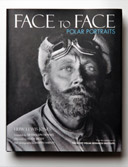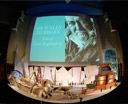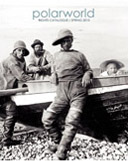 Our ProductsOur Resources |
This website requires the free Flash plugin to be installed.
Polarworld - discover more polar booksThe Arctic Book Review The Arctic Fox: The Arctic Fox: Francis Leopold McClintock, Discoverer of the Fate of Franklin David Murphy Reviewed by Russell A. Potter The past decade has witnessed a striking efflorescence of interest in the Arctic explorers of the classic era of British polar exploration. A plethora of books, some more successfully than others, have sought to resuscitate the fame of these long-neglected figures: Sir Ernest Shackleton, Sir John Ross, Sir George Back, Dr. John Rae, Sir John Franklin, and Samuel Hearne have all been the subject of new biographies and studies. Yet of all these figures, the one whose reputation in his day was the greatest — and whose fall from fame the steepest — may well be Sir Francis Leopold McClintock. Hailed, as the title echoes, as the ‘discoverer of the fate of Franklin,’ McClintock’s account of that expedition, The Voyage of the ‘Fox’ in Arctic Seas, was the best-selling book of its day, attracting more readers than Tennyson or George Eliot and swiftly translated into every major European language. The novelist Joseph Conrad, born in the year of its publication, came upon an edition in French when he was only ten years old. Recalling the event late in life, he credited that early encounter with McClintock’s book with inspiring his career, both as a seaman and a writer: There could hardly have been imagined a better book for letting in the breath of the stern romance of polar exploration into the existence of a boy whose knowledge of the poles of the earth had been till then of an abstract, formal kind, as the imaginary ends of the imaginary axis upon which the earth turns . . . The great spirit of the realities of the story sent me off on the romantic explorations of my inner self; to the discovery of the taste for poring over land and sea maps; revealed to me the existence of a latent devotion to geography which interfered with my devotion (such as it was) to my other school work. Conrad’s praise was echoed by many others in his era, and yet when the list of notable Arctic explorers is recited today, McClintock’s name is all too often absent, or confined within parentheses after the far more prominent name of Franklin. David Murphy’s new biography, the first full-length treatment in nearly a century, will do a great deal to rectify this situation. Murphy, an editorial assistant with the Dictionary of Irish Biography, brings a new focus to McClintock and other leading explorers with Irish roots and connections, along with some materials — hitherto neglected — in Irish archives and museums. It is one thing to read, for instance, about McClintock shooting a polar bear on the ice, and quite another to see a full-page photograph of that very bear, mounted an in the collection of the Natural History Museum in Dublin. The Irish focus provides a significant, though subtle difference in accentuation to Murphy’s account; while it has often been observed how many Scots played leading roles in Arctic exploration, the Irish — among them Kellett, McClure, and Crozier, as well as McClintock -- also made up a key contingent among Britain’s best Arctic commanders. For the most part, Murphy tells his subject’s story as a straightforward chronological narrative, drawing at points upon private and published journals and letters to add detail to his account. For those familiar with McClintock’s career, there will be few surprises, though his role in developing and experimenting with Arctic sledge-travel, a less-well-known accomplishment, is here given a remarkably thorough and detailed treatment. Outside of Arctic sledgers themselves, few people likely realize that McClintock very nearly invented the British mode of sledge-travel; that he employed dogs on a number of occasions and was impressed by the speed obtained; or that he continued consulting with and designing the sledges and supplies for polar expeditions right on through to the era of Robert Falcon Scott. It may be wished that the advantages of dogs had been realized sooner, but McClintock was never so doctrinaire in his preference for man-hauled sledges as the detractors of this British custom have implied. The success of his sledge-trips — in which he rarely lost a man, and repeatedly set records for distance and duration — is testimony enough to his attention to detail, and willingness to improvise and improve whenever a better method suggested itself. Murphy sets these and others of McClintock’s accomplishments in the context of his remarkably long career. Born in Dundalk in 1819, he joined the navy at the tender age of eleven in 1831, eventually working his way up to a position as gunnery officer aboard HMS Gorgon in 1843. The Gorgon, one of the Royal Navy’s new class of paddle steamers, was dispatched to the South Atlantic as part of a squadron to protect British shipping during the civil war in Uruguay. By an unfortunate turn of the tide, the Gorgon was forced aground in a violent storm, and its officers and crew awoke the next morning to find the ship embedded 13 feet deep in the sand a great distance from open water. McClintock’s role in leading the crew in the back-breaking work of digging out and re-floating the ship earned him his captain’s praise and a lieutenant’s commission — and it’s hard for the reader to avoid seeing the episode as prelude to similar difficulties struggling with the equally implacable ice. McClintock’s first connection with the Arctic came at the very start of the search for Franklin; as second officer aboard the Investigator during James Clark Ross’s 1848-49 search, he organized the first extended sledge-trips ever dispatched from a Royal Navy expedition (J.C. Ross’s own during the private "Boothia" expedition of 1829-33 had been the very first), learning from an experienced commander the difficulties of stowage, rationing, medical care, and food preparation when out many days from the safety of the ships. It is ironic, as Murphy notes, that McClintock’s very first sledge journey brought him closer to the actual location of Franklin’s men than any subsequent expedition until his own ten years later — had he been able to continue, his would have been the only party which might have effectively contacted or relieved the lost explorers before it was too late. McClintock continued to volunteer for Arctic service, serving with distinction as first lieutenant aboard the Assistance (1850-51) and in command of the Intrepid in Belcher’s squadron (1852-53). On both expeditions, he organized extensive sledge-journeys; on the second, he relayed messages to Belcher via dog-drawn sledges. He was amazed at the speed with which the dogs traveled, but did not, apparently consider it a sufficient advantage to abandon man-hauling sledges as a general practice. Twice he sledged to Melville Island, the second time as part of an extended journey to unexplored regions to the northwest, where he discovered and named Prince Patrick Island. The ignominious retreat of Belcher’s squadron the following spring, accomplished via the abandonment of ships in perfectly good order, was a source of immense frustration to McClintock, and no doubt the vindication provided when Kellett’s Resolute managed to pilot itself to safety was a rather cold consolation. Murphy relates how McClintock, while not directly seeking to organize further searches, kept the pressure up with public lectures and comments, and — perhaps most importantly — kept in touch with Lady Franklin during the forced interim of the Crimean War. When her Ladyship finally decided to organize a return expedition in 1857, McClintock was the logical choice to command it, a commission he accepted instantly (Murphy notes that his reply to Lady Franklin’s request was posted the same day he received her letter). Murphy’s account of McClintock’s eventful search of 1857-59 is somewhat dry, considering the intense drama of the circumstances; he adds little to what has often been told, and repeats some (mostly minor) errors of secondary sources. Yet he more than makes up for this in the succeeding chapter, "The Fate of Franklin," in which he navigates adroitly among the seemingly innumerable claims and counter-claims of Franklin searchers and researchers. Lead poisoning is given some consideration, but is ultimately dismissed, along with botulism, as a factor of much significance. Franklin himself is given short shrift indeed; Murphy clearly regards the British ideology of the "noble failure" with disdain. That cannibalism occurred among the crews is accepted as fact, and the claims of its doubters are, somewhat brusquely, dismissed. All this is deserved, I suppose — and in terms of getting the overall story straight, Murphy’s is the best of many recent accounts — but it’s unfortunate to see a veteran explorer such as Rebecca Harris, who in 2003 literally walked in Franklin’s footsteps from Point Victory to "Starvation Cove," discounted as "naïve." Having spent a few days myself on King William Island with Ms. Harris, I would readily agree with her basic claim, which is that the extremity of the climate, and the poorness of the provisions, are more than ample to explain the demise of Franklin’s crews. What happened, though, in the final extremity of their suffering, is difficult to see with total clarity, and probably always will be. It’s my own feeling that, among at least one group of survivors, cannibalism did occur, and if it did, I don’t see how it would diminish one’s admiration for these men. If there is a villain, it is the stultified bureaucracy of the Admiralty which — as Murphy quite pointedly notes — frequently endorsed lunatic schemes, such as message-balloons and inscriptions on fox-collars, while ignoring good arguments on where and how to send help. Another welcome contribution of this book commences at just the point where the Franklin story ends — I for one was totally unaware of McClintock’s long career after his search expedition. It was to be twenty-five years before he retired at the rank of Admiral; during that time he surveyed routes for the transatlantic cable, stood (unsuccessfully) for a seat in Parliament, served as aide-de-camp to Queen Victoria, and was appointed as admiral-superintendent of the Portsmouth dockyard. Throughout this period, and even after his retirement, he was frequently called upon for advice on Arctic exploration; he oversaw preparations for the Nares expedition, and even — just a few years before his death — advised Sir Clements Markham on the design and outfitting of R. F. Scott’s ship Discovery. He lived just long enough to be toasted at a dinner celebrating the fiftieth anniversary of his expedition aboard the Fox, dying on 17 November, 1907 after a bout of pneumonia. The full legacy of McClintock’s accomplishments is, perhaps, easier to see today, now that the wisps of polar romance, as well as the cobwebs of historical negligence have been blown away. We are a more realistic bunch than our Victorian forebears, less tolerant of cultural blindness and less enchanted by notions of nobility and sacrifice. David Murphy gives us an apt biography for our times — though I also suspect that, could he peer down from his unearthly pole, the ghost of McClintcok would be pleased by a biography that tells his story straightforwardly, without seeking to add to the intrinsic drama provided by the events themselves. Here is a worthy addition for any collection of Arctic books, returning to its proper place the life of the last — and the foremost — explorer of the Franklin era. |
|
||
follow us  | join us | join us  | home | contact | home | contact
|
||||
|
© Copyright Polarworld Ltd
SiteWizard.co.uk Web Site Design Company |
||||


